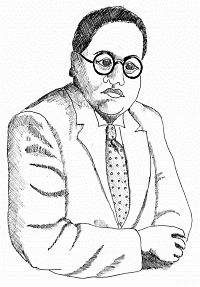Dr Bhimrao Ramji Ambedkar
ढॉ भीमरव रामजी आंबेडकर
Dr Ambedkar (1891 – 1956), known by his followers as Babasaheb, was born into an 'untouchable' caste and subject to all kinds of prejudice. Being untouchable in pre-independence India was to be consigned to a life of difficulty: denied access to resources, education, and medicine. Untouchables were forbidden to use communal facilities (especially water) because they would 'pollute it'. This prejudice was built upon religious superstition given sacred status by "Law" books like the Manusmṛti.
However through luck and perseverance Dr Ambedkar was able to overcome many of the obstacles placed in his way by society. Through the intercession of a patron he managed to get an education that culminated in a PhD from the London School of Economics. He also became a Barrister. When India gained independence he was called to be the first Law Minister and was responsible for framing the Indian Constitution.
Dr Ambedkar never forgot his humble origins however and constantly strove to improve the conditions of his people. The Constitution outlawed the practice of untouchability. To mark this change the people of the low castes began to refer to themselves as Dalit 'the oppressed'. The term 'untouchable' always was quite offensive, and even referring to Dalits as "former untouchables" is impolite (at best). The illegality of untouchability has not stopped Dalits from being oppressed, and especially in rural it has not stopped Dalits being harassed, abused, and even raped and murdered because they step outside the traditional options open to them. The newspapers of Indian give bleak testimony to the regular attacks on Dalits. Part of Ambedkar's legacy however is a quota system for Dalits for government jobs. This positive discrimination is sometimes resented by other Indians, but without it the continuing prejudice against Dalits would mean there were few opportunities for advancement. That said the present chief minister of Uttar Pradesh is from a Dalit background, and was able to gain office by appealing to the Dalits vote.
Dr Ambedkar never forgot his humble origins however and constantly strove to improve the conditions of his people. The Constitution outlawed the practice of untouchability. To mark this change the people of the low castes began to refer to themselves as Dalit 'the oppressed'. The term 'untouchable' always was quite offensive, and even referring to Dalits as "former untouchables" is impolite (at best). The illegality of untouchability has not stopped Dalits from being oppressed, and especially in rural it has not stopped Dalits being harassed, abused, and even raped and murdered because they step outside the traditional options open to them. The newspapers of Indian give bleak testimony to the regular attacks on Dalits. Part of Ambedkar's legacy however is a quota system for Dalits for government jobs. This positive discrimination is sometimes resented by other Indians, but without it the continuing prejudice against Dalits would mean there were few opportunities for advancement. That said the present chief minister of Uttar Pradesh is from a Dalit background, and was able to gain office by appealing to the Dalits vote.
One of Dr Ambedkar's aims as a politician was to rid India of caste, a project which was opposed by Gandhi. Towards the end of his life Ambedkar observed that in many ways the Dalits lot had not improved, and would not while they remained subject to the caste system. He determined to change this by converting away from Hinduism, and after some research decided to become a Buddhism. At his formal conversion in Nagpur, he also lead the conversion of approximately half a million of his followers. Sadly Dr Ambedkar died not long afterwards, but millions of his followers continued to convert to Buddhism.
Sangharakshita was in contact with Dr Ambedkar at around this time, and after his death gave a number of speeches in Nagpur and other cities encouraging his followers not to lose heart. Many years later in the 1970s when some of Sangharakshita's students went to India they reconnected with some of Sangharakshita's Ambedkarite friends and went on to run Tiratna Bauddha Mahāsangha activities in India.
Indian Buddhists see Dr Ambedkar, Babasaheb, as a Bodhisattva and find inspiration in his life example. In the Triratna movement we usually see pictures of Dr Ambedkar and Sangharakshita flanking the Buddha rūpa. However because so many of the Dalits are very poor and live in rural areas they are only nominally Buddhist. One of the goals of the Triratna movement in India, and especially in Bodhgaya, is to go out to these people and offer them fellowship as well as instruction in Dhamma and meditation in their local language where possible, or in Hindi at least.
Jaya bhim! (जय भीम) is how Indian Buddhists greet each other. It means 'victory to Dr Ambedkar' (his first name being Bhimrao (भीमरव)
More information
Jaya bhim! (जय भीम) is how Indian Buddhists greet each other. It means 'victory to Dr Ambedkar' (his first name being Bhimrao (भीमरव)
More information
- ambedkar.org
- Wikipedia article.
- Sangharakshita. Ambedkar and Buddhism. (ebook)
- Nagabodhi (Terry Pilchick). Jai Bhim: Dispatches from a Peaceful Revolution. (ebook)

